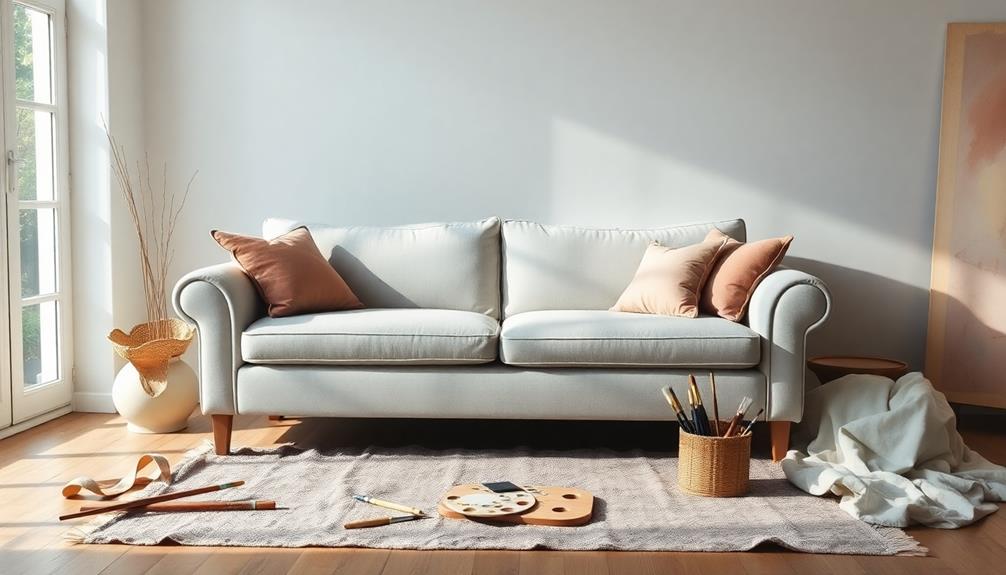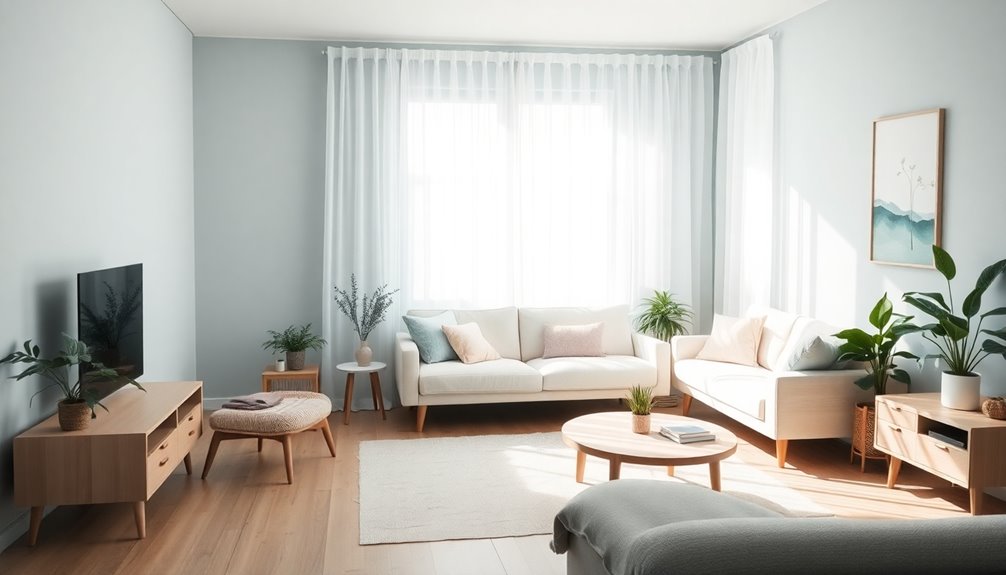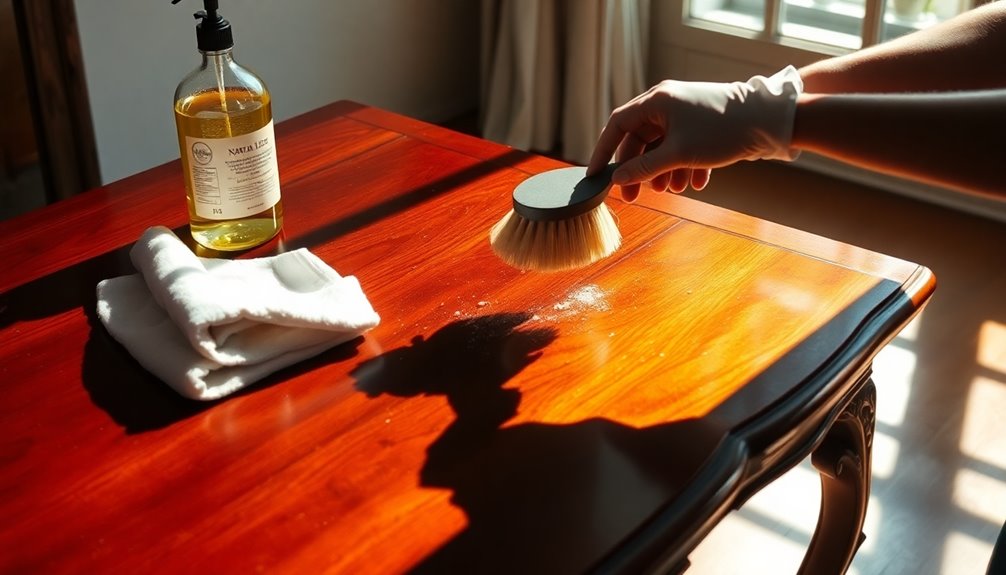You can easily give your fabric furniture a makeover by following a few important steps. Begin by selecting durable materials like cotton or poly blends and steer clear of regular paints. Thoroughly clean the fabric, spot-treating any stains, and lightly dampen it. Utilize specialty upholstery paints and apply them in thin, even coats using a spray technique for a flawless finish. After each coat, gently sand the surface and finish off with a fabric-safe topcoat for long-lasting results. Don’t forget to keep your newly painted furniture clean and touch up any areas as necessary. Explore more helpful tips and techniques to perfect your painting project!
Key Takeaways
- Choose durable, smooth fabrics and use specialty upholstery paints for better adhesion and results.
- Thoroughly vacuum and spot clean the fabric before painting to ensure a clean surface.
- Apply paint in thin, even layers using the spray method to minimize brush strokes and achieve a uniform look.
- Lightly sand the painted surface between coats for a smooth finish and apply a protective topcoat for durability.
- Maintain painted furniture by cleaning regularly, inspecting for wear, and performing touch-ups as needed.
Selecting Suitable Fabric and Paint
When you're ready to paint your fabric furniture, selecting the right fabric and paint is vital for achieving a successful outcome.
Start by choosing durable materials like cotton or poly blends, which provide better results than textured fabrics like velvet. Smooth fabrics allow for improved adhesion, ensuring the paint adheres properly to the upholstery.
Additionally, consider using essential oils like peppermint oil for its invigorating scent that can help alleviate any potential stress during the project.
When it comes to paint, avoid standard latex paint or acrylics, as they can create stiff, crunchy textures. Instead, opt for specialty upholstery paints, such as Sherwin Williams Emerald Latex paint, known for its low VOC and anti-microbial properties. These features make it suitable for your upholstery projects while maintaining a soft feel.
Before diving in, always test the paint on a small, inconspicuous area of your fabric. This step is significant for checking adhesion and finish quality.
Additionally, consider the weight and mobility of your furniture when choosing the paint and fabric type, as these factors influence how well the paint will hold up over time.
Preparing Your Furniture for Painting

Preparing Your Furniture for Painting
Start by thoroughly vacuuming the upholstery to eliminate dust and debris, creating a clean surface for ideal paint adhesion. Once you've vacuumed, inspect the fabric for any visible stains. Spot clean these areas to prevent discoloration during the painting process, which could affect the final appearance of your furniture.
Additionally, consider the energy efficiency of your workspace, as a well-lit and ventilated area can enhance your painting experience and results. Take note of energy-efficient appliances that can help maintain a comfortable environment while you work.
Next, lightly dampen the fabric with a spray bottle filled with water. This step enhances paint absorption and helps prevent damage during application. Before diving into painting, it's essential to test your chosen paint on a small, inconspicuous area of the fabric. This guarantees compatibility and helps you achieve your desired finish.
Don't forget to protect areas of the furniture that you don't want to paint. Use painter's tape to create clean lines and prevent any overspray from reaching those surfaces. Always ensure the tape is pressed down firmly to avoid any paint bleeding underneath. If you’re wondering *how to paint veneer furniture*, the key is proper preparation—lightly sand the surface and apply a good primer to ensure the paint adheres well. This will help create a smooth, durable finish that looks professional. Additionally, make sure to choose the right type of paint for your project, such as acrylic or latex, which work well on a variety of surfaces. When learning *how to paint veneer surfaces*, patience is crucial—apply multiple light coats of paint, allowing ample drying time between each layer. This technique will help avoid drips and ensure a solid, even finish.
Application Techniques for Best Results
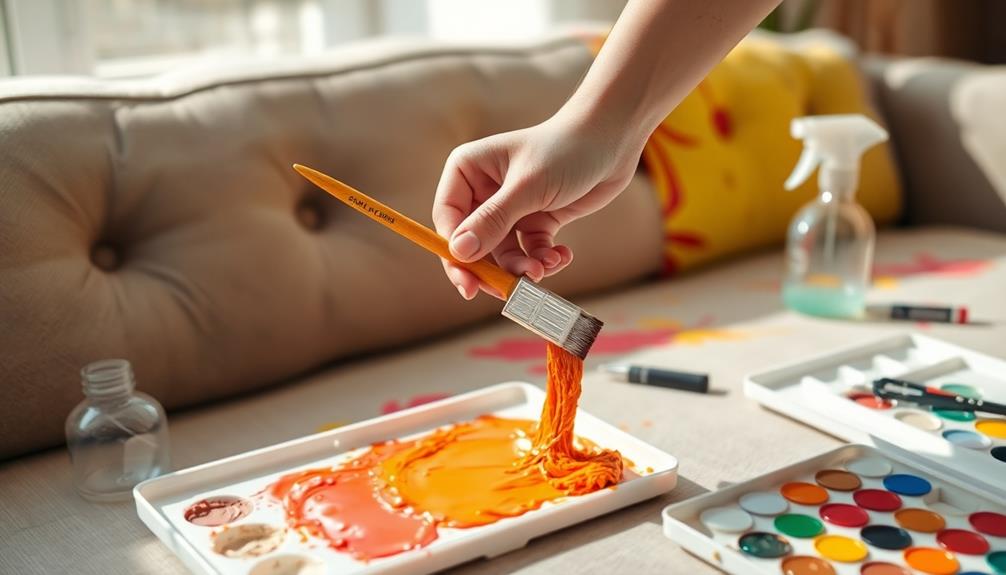
With your furniture prepped and ready, it's time to focus on application techniques that will yield the best results. Start by applying paint fabric in thin, even layers rather than one thick coat. This approach prevents stiffness and guarantees better adhesion.
For a smoother finish, utilize the spray method; it minimizes the risk of brush strokes and provides a uniform look. Additionally, just as different brewing methods can affect the overall experience of coffee, varying painting techniques can greatly impact the final appearance of your furniture innovative coffee gear.
Before you begin painting, dampen the fabric lightly with water. This step enhances absorption, creating a dye-like effect that results in ideal color saturation. As you paint, aim for even layers to achieve your desired look. If you're blending colors, do it while the paint is still wet to guarantee seamless shifts.
After each coat has dried, lightly sand the surface with fine-grit sandpaper (320 to 400 grit). This technique helps to achieve a soft texture and smooth finish, preparing the fabric for additional layers.
Sanding and Finishing Touches
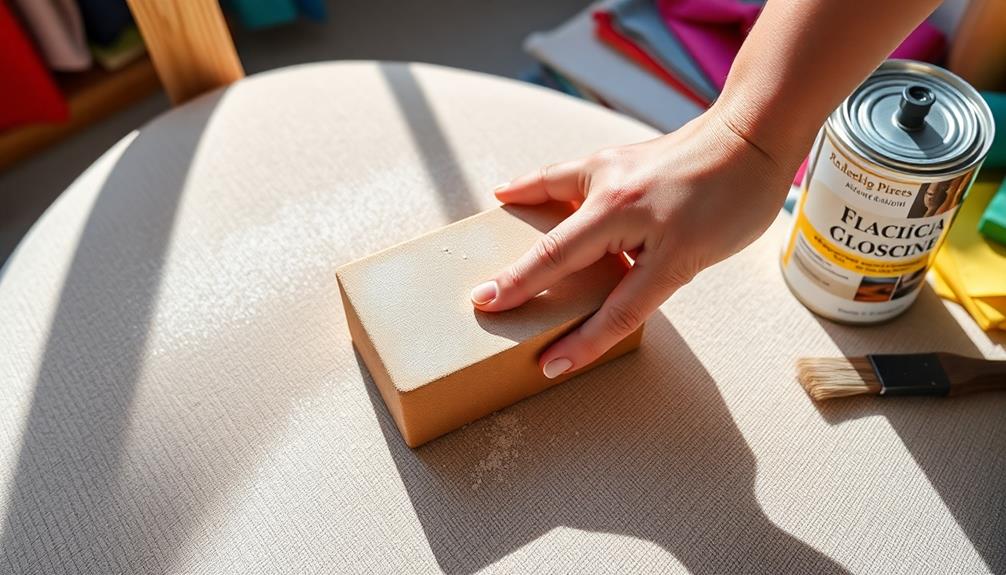
Sanding your painted fabric furniture is vital for achieving a smooth, professional-looking finish. After applying each coat of paint, let it dry thoroughly before you start sanding.
Use 320 to 400 grit sandpaper to gently sand the surface. This step prevents buildup and enhances paint absorption for additional coats, ensuring a supple texture that feels soft to the touch.
Once you've finished your final coat, it's essential to clean up any dust with a damp cloth. This preparation allows the protective topcoat to adhere properly.
After wiping down the surface, consider sealing your piece with a fabric-safe topcoat. This not only enhances durability but also protects against spills, prolonging the life of your beautifully painted upholstery.
Maintaining Your Painted Furniture
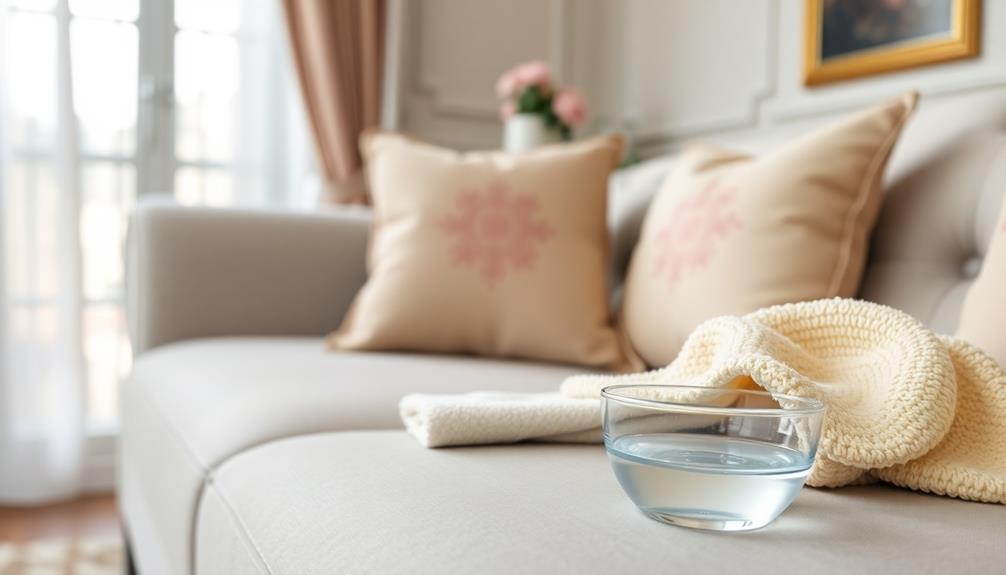
To keep your painted fabric furniture looking its best, you'll want to stay on top of regular cleaning and maintenance. Start by regularly wiping down your furniture with a damp cloth and mild soap. This prevents dirt buildup while protecting the painted surface. Remember, harsh chemicals or abrasive cleaners can damage the paint, leading to peeling or discoloration.
Occasionally, add fabric softener to your cleaning routine to maintain the softness of the fabric, alleviating any stiffness. Regular inspection is key; check for signs of wear like chips or scratches. If you notice any, promptly perform paint touch-ups with leftover paint to keep everything looking seamless.
To further protect your furniture, keep it out of direct sunlight to prevent fading and maintain that vibrant look.
Here's a quick reference table to help you with maintenance:
| Maintenance Task | Frequency |
|---|---|
| Wipe down with soap | Weekly |
| Add fabric softener | Monthly |
| Inspect for wear | Every 3 months |
| Touch-up paint | As needed |
| Move away from sunlight | Always |
With these tips, your painted furniture will stay beautiful for years!
Frequently Asked Questions
What Kind of Paint Do You Use on Fabric Furniture?
When choosing paint for fabric furniture, consider chalk paint for its adherence and matte finish, or specialized upholstery paint for durability. Fabric spray paint works well for large areas, ensuring even coverage and quick application.
What Is the Best Paint for Fabric?
When choosing the best paint for fabric, consider using high-quality chalk paint for a soft finish, specialized upholstery paint for durability, or fabric spray paint for large areas. Always test on a small area first.
How to Paint a Couch and Keep It Soft?
To paint a couch and keep it soft, vacuum thoroughly, dampen the fabric, and use a chalk paint-water mix. Apply thin coats, sand lightly, and finish with a fabric softener rinse for comfort. After allowing the final coat to dry completely, consider applying a fabric protector to enhance durability and maintain the softness of the couch. This process demonstrates how to paint furniture easily while ensuring the end result remains both functional and stylish. With a little patience and the right materials, you can rejuvenate your furniture without compromising its comfort.
Does Fabric Paint Need Primer?
While primer isn't always necessary, using it can enhance adhesion and color vibrancy on certain fabrics. Test a small area first, and follow manufacturer recommendations to guarantee you get the best results for your project.
Conclusion
To sum up, painting your fabric furniture can breathe new life into your space and save you money. Did you know that over 60% of homeowners choose DIY projects to personalize their living spaces? By following the right techniques, you can achieve stunning results that reflect your style. Remember to maintain your newly painted pieces to keep them looking fresh and vibrant. So grab your supplies and get started on transforming your furniture today!
